ENCOUNTERS WITH AMATUL BAHA RUHIYYIH KHANUM
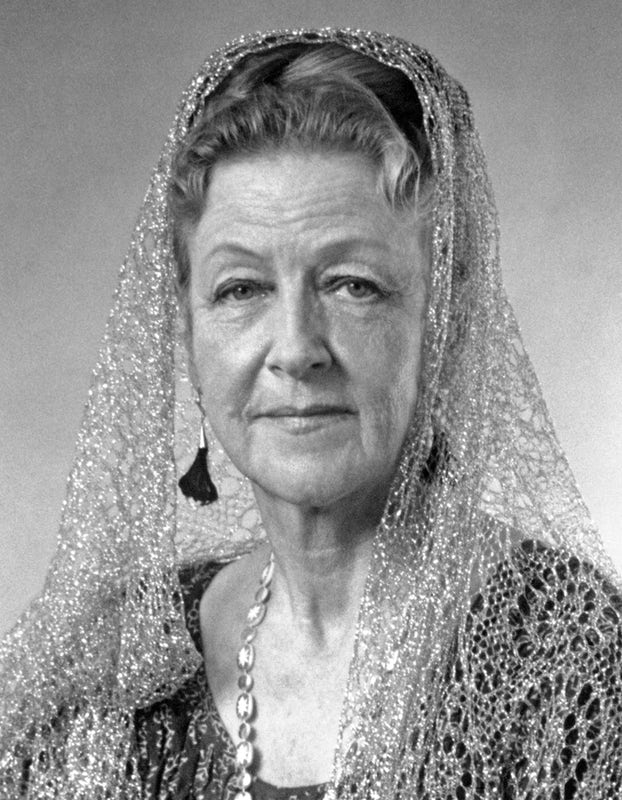 Amatu’l-Bahá Rúhíyyih Khánum
Amatu’l-Bahá Rúhíyyih Khánum
The bulk of this story concerns our personal experience when Hand of the Cause of God Amatu’l-Bahá Rúhíyyih Khánum and her colleague Violette Nakhjavani (wife of a member of the Universal House of Justice, Ali Nakhjavani) who came to Fiji in 1984 for two weeks prior to going to Samoa for the dedication of the Samoan House of Worship in Apia. However, there were other events around our relationship with Rúhíyyih Khánum which I will add to this story.
Richard and I married in Fiji in August 1971 and immediately applied to go on pilgrimage. This took place in May 1973 and was the first lot of pilgrims following the election of the members of the Universal House of Justice that year. Rúhíyyih Khánum had just returned from being away for 6 years on her African Safari and our group of pilgrims were the first she would talk to since her return. At the gathering of our pilgrimage group Rúhíyyih Khánum asked around about where we had come from. When we told her Fiji she seemed to spend the rest of her talk directed to us, saying among other things that she hoped to come to Fiji at some time in the future.
Rúhíyyih Khánum and Violette Nakhjavani first visited Fiji in 1979 on their way to Samoa to lay the foundation stone for the House or Worship. Verona gave birth to Andrew in January of that year. Verona still had project work in Namosi, near Suva, ongoing so she asked her brother Alan if he could spare some time to come to Fiji and help with driving from Lautoka to Suva in February or March. So it came to pass that Alan, Verona and Andrew were among the Bahá’ís who greeted the two important visitors when they arrived at Nausori airport near Suva.
The only other contact they had at that visit was a meeting with all the Bahá’ís in Sigatoka at the Bahá’í Centre which was hired for the teaching work that was going on at that time.
Prior to coming to Fiji in 1984 Rúhíyyih Khánum and Violette did an extensive tour of the Pacific including Papua New Guinea, the Solomon Islands, Vanuatu and Kiribati. As the plane coming from Kiribati stopped in Tuvalu en route the Bahá’ís of Tuvalu took her off the plane to their center, not far from the airport, and gave her a wonderful welcome before rushing her back to the plane to Fiji. When we checked for the time when the plane was due we were informed it was already on the ground so we made haste to cover the 20 minute drive to the airport. When we arrived Rúhíyyih Khánum called out “Where are the Lucas’s?”
Rúhíyyih Khánum and Violette were taken to the Mocambo Hotel where a room had been booked for them. Rúhíyyih Khánum was not happy about the location of the room and we had to help sort that out and find a more suitable room. The recommended program was presented to her and she informed us that she had to have time for herself and the timetable was adjusted accordingly after explaining that the program was not set and that her situation was the most important. It was clear to Verona that Rúhíyyih Khánum was tired and Verona had the distinct impression of Shoghi Effendi standing behind her. When they left Doris Carne nudged Verona and said “Shoghi Effendi was in that room”. “I know” was the reply. We did not have that experience again but we understood that Shoghi Effendi was taking care of Rúhíyyih Khánum.
THE STORY AS WRITTEN SOON AFTER THE EVENTS DESCRIBED HAPPENED
Rúhíyyih Khánum and Violette Nakhjavani arrived in Fiji Sunday the 12th of August 1984 for a two week visit as part of their Pacific travels, prior to dedicating the Mashriqu’l-Adhkár of Samoa. They flew from Kiribati and were expected in Nadi at 4:45 PM. Their plane arrived unexpectedly early so they waited at the airport for the Fiji Bahá’ís to arrive helter skelter, like Brown’s cows. Among the welcoming party were four members of the National Spiritual Assembly and an Auxiliary board member. Rúhíyyih Khánum, was welcomed with two salu salu’s and a basket of fruit with a bottle of Lomawai honey. After greeting everyone at the airport Rúhíyyih Khánum and Violette Nakhjavani were taken to Macambo hotel for consultation with the National Spiritual Assembly members about their programme in Fiji. This programme was to begin with a meeting of the Bahá’ís in the western division at the Lucas home in Lautoka on the evening of Tuesday the 4th of August. On Tuesday evening Rúhíyyih Khánum and Violette Nakhjavani arrived at 7:30 PM at the Lucas home where nearly 30 Bahá’ís had gathered. First the visitors were garlanded by David and Ronald Lucas then prayers were read. Rúhíyyih Khánum spoke to us of her recent adventures in the other Pacific islands. When the Moce Bahá’ís arrived, (being late because they had to travel from their work cutting sugar cane) there were about 50 Bahá’ís. After the formal talk a supper was served and Rúhíyyih Khánum and Violette met individuals and talked informally to them.
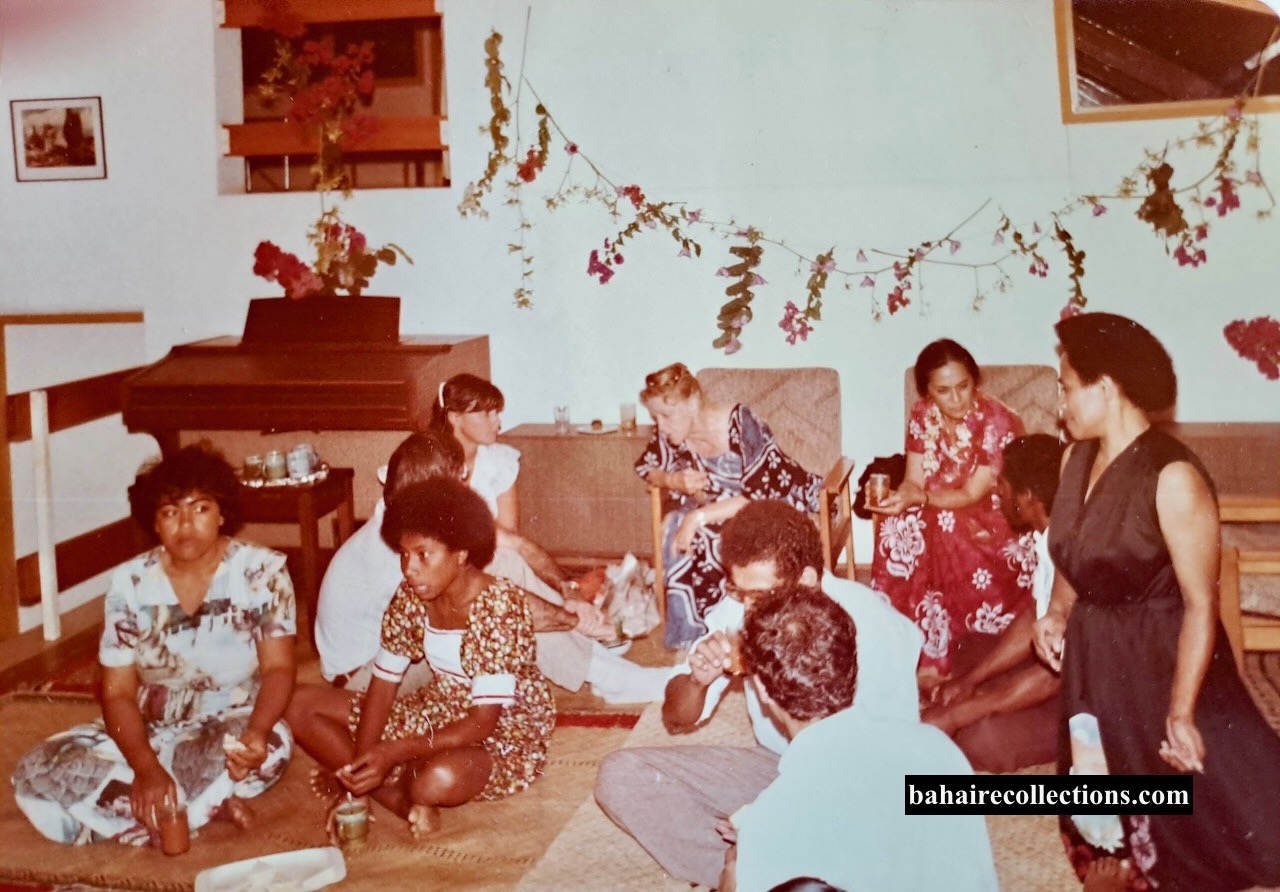 Rúhíyyih Khánum meeting the believers at the Lucas residence
Rúhíyyih Khánum meeting the believers at the Lucas residence
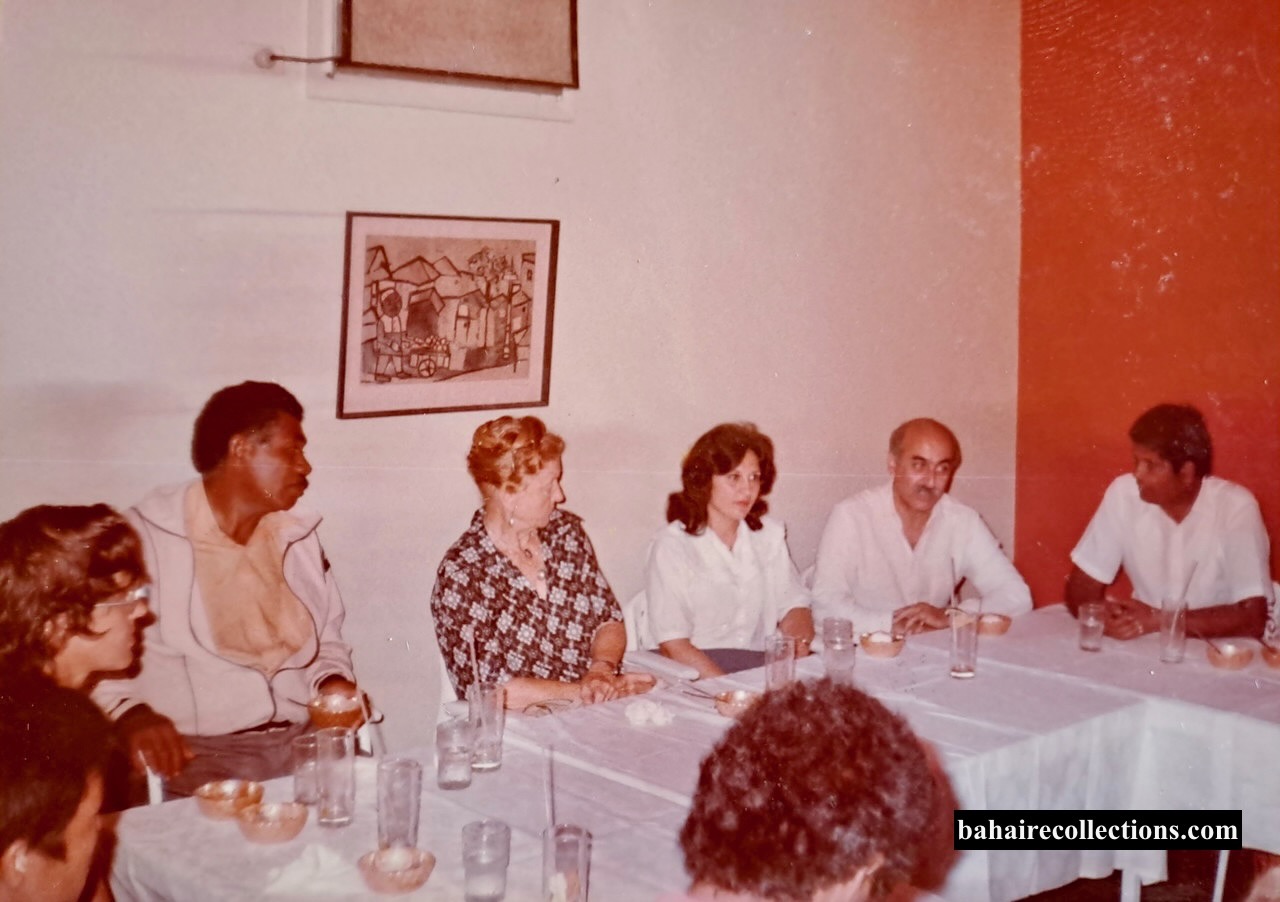 Rúhíyyih Khánum having dinner with believers in Suva
Rúhíyyih Khánum having dinner with believers in Suva
Next day Rúhíyyih Khánum met some of the Indian believers in the Savu Savu Bahá’í Centre and at Lomawai . Here one elderly lady 83 complained to Rúhíyyih Khánum about why she had only heard of the Faith two years ago. Rúhíyyih Khánum was quick to reply that she was 74 and travelling around the world so the old lady could still teach at her age. On the 16th of September Rúhíyyih Khánum and Violette left Nadi to travel by with a stop at Yadua village to meet the Bahá’ís and have lunch at the village on the way. The Bahá’ís at Yadua expected Rúhíyyih Khánum at 12 but she was scheduled to arrive at 10 so Rúhíyyih Khánum decided to solved the problem with a request to visit Sigatoka township. In Sigatoka market, Rúhíyyih Khánum looked for beads to use as prayer beads and thoroughly enjoyed poking around the market and driving very hard bargains with the Indian sellers used to taking off the tourists. The delays served a useful purpose. Counsellor Tinai Handcock was unexpectedly due in Fiji at 11:45 AM so she was met at the airport and asked if she would like to travel to Suva by road with Rúhíyyih Khánum and she agreed. Tinai arrived in time to join everyone for lunch, much to the surprise of Rúhíyyih Khánum and Violette. The Bahá’ís of Yadua gave Rúhíyyih Khánum a formal welcoming ceremony to Fiji with yagona (kava) and presented a valuable Tabua.
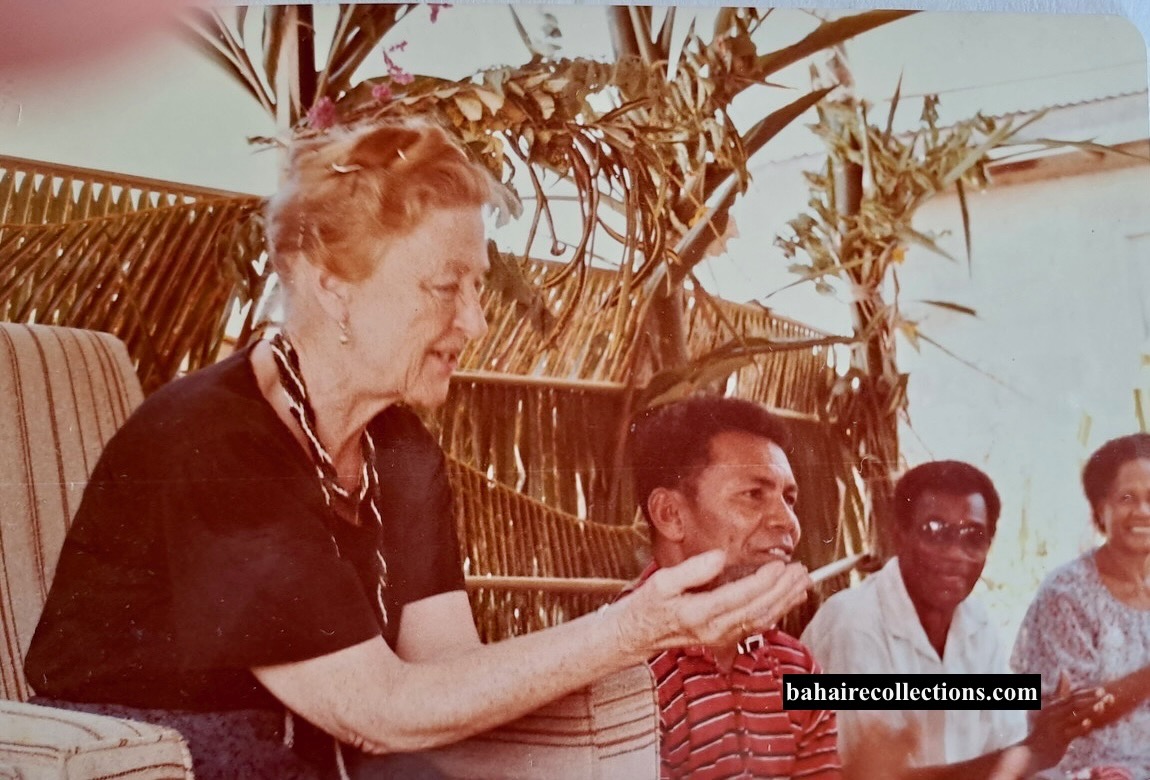 Presentation of Tabua (tooth of whale)
Presentation of Tabua (tooth of whale)

Rúhíyyih Khánum receives ceremonial kavs
Friday the 17th Rúhíyyih Khánum met the press in Suva and in the evening the Bahá’ís of Nasinu and Suva organised a special dinner and meeting for her. Saturday Rúhíyyih Khánum had a meeting with the Bahá’ís of Rewa at Navuso village, where she was again presented a formal yagona ceremony and tabua. The presentation was made by a High Chief’s son who is a Bahá’í and was dressed in full Fijian regalia. Sunday morning there was a meeting with the youth at the Suva Bahá’í Centre and at 3:00 PM Rúhíyyih Khánum met with the pioneers at Diana and Dale Hudson’s place. Monday, Rúhíyyih Khánum met the Indian High Commissioner and Governor General of Fiji. Tuesday the 21st Rúhíyyih Khánum and Violette flew from Suva to Labasa where they were met by Verona Lucas, Jone Salele and Mika Malau. Rúhíyyih Khánum’s first engagement was a public meeting at 6:00 PM, so while Verona and Jone spent the afternoon travelling to Seaqaqa to tidy up arrangements for a conference the next day, Rúhíyyih Khánum and Violette went shopping. They had a wonderful time buying saris for gifts for friends in India. Included was a special sari to be used to cover the table on which a portrait of Bahá’u’lláh would be displayed for special viewing in the House of Worship in Samoa.
The public meeting was attended by few people so Rúhíyyih Khánum addressed the group informally. Wednesday the 22nd was programmed for Rúhíyyih Khánum to address the Bahá’ís of Vanua Levu at Mitieli’s place in Seaqaqa. A special bus was arranged to transport the Bahá’ís to the meeting. The morning was free but Rúhíyyih Khánum wanted to do some more shopping, a reporter wanted an interview and Jone Salele wanted her and Violette to come to his place for lunch. It all was fitted in. The reporter was late, but it turned into a teaching session because he was fascinated by the Faith. Rúhíyyih Khánum and Violette got their shopping done after leaving Verona and Jone at their room to wait for the reporter. Jone went off to prepare lunch at his home. He got Verona to make scrambled eggs which she had never done in a beat-up old frying pan over an open fire in a Fijian kitchen before – but it was well made. On the way to Jone’s place we drove past the Labasa sugar mill and Rúhíyyih Khánum asked if we could get some molasses. We decided to call at the mill on the way back and Jone brought a half gallon container with us. When we arrived at the mill Ruhi Rúhíyyih Khánum suddenly announced that she’d like to see over the mill because she’d never seen a sugar mill and didn’t see why she shouldn’t see one in her life. So, Jone found a young man to guide us and tromp through the whole sticky process. At the end of the line where sugar is centrifuged, and the molasses run off the half gallon container was held under a tap and rapidly filled. It was a great experience for Rúhíyyih Khánum commented on how like making Bahá’ís the sugar producing process was. Crushing the cane, heating and separating crystals from molasses a long way from the cane fields. The half gallon was such a lot of molasses that Rúhíyyih Khánum told Verona she would take some for herself and give the rest to her when they met in Suva. Alas for Verona. Rúhíyyih Khánum travelled with us to a dinner meeting in Suva and she leaned over and said: “I have bad news for you. That molasses is the best I have ever tasted so I am keeping it all and you can get some for yourself”.
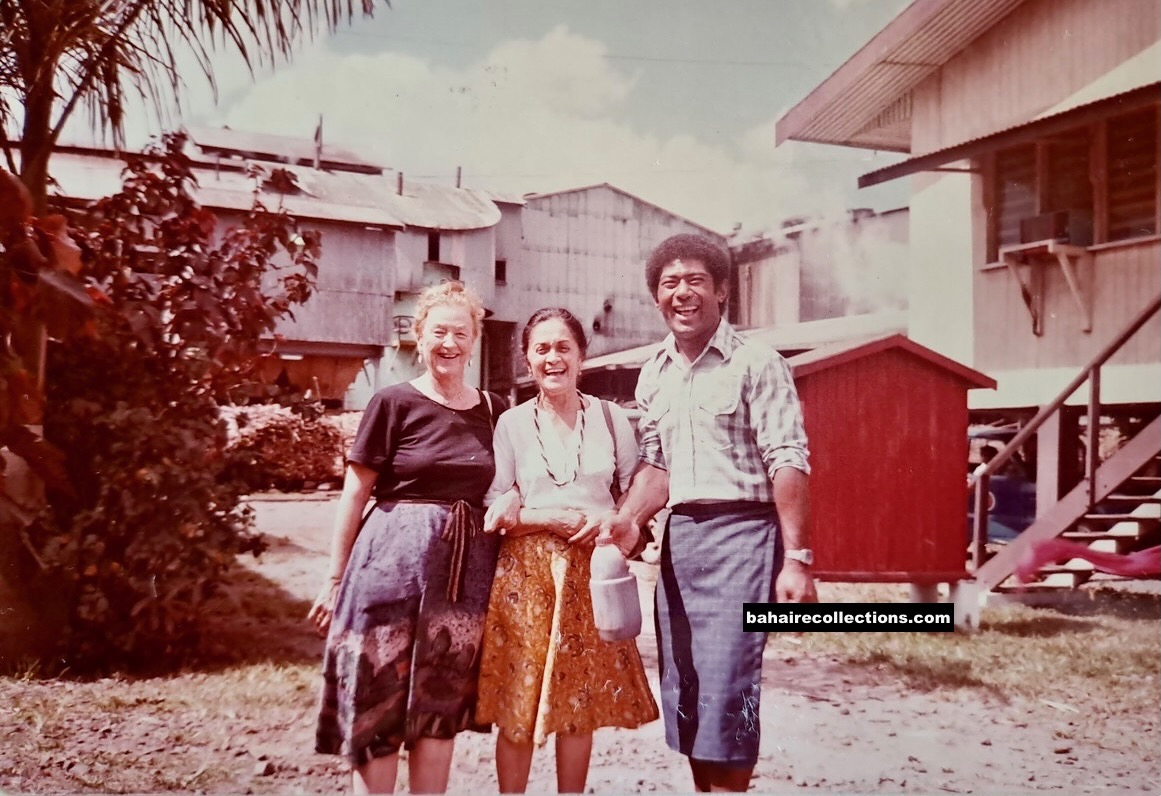
At the sugar cane mill. L-R: Rúhíyyih Khánum, Violette and Jone Salele.
At Seaqaqa we had another lunch and Violette told me how they had eaten 5 lunches one day in Africa. One of the Bahá’ís was waiting at Seaqaqa town for the bus which had already arrived. Verona was asked to go and get him. On the way out the car had a flat tyre and the Seaqaqa garage couldn’t repair it. The thought of travelling back into the bush with no spare was horrifying so Mitieli made his own way to the meeting and Verona drove half an hour back to Labasa to get the tyre fixed. It was as well. A new tube was required and the spare she had put on the vehicle was torn on the wall and a new tyre was put on that wheel as well. Verona arrived at the meeting at 4:45 PM. Rúhíyyih Khánum had got the meeting underway at 3:00 PM and was still talking. The meeting finished an hour later and we left at 6:00 PM.
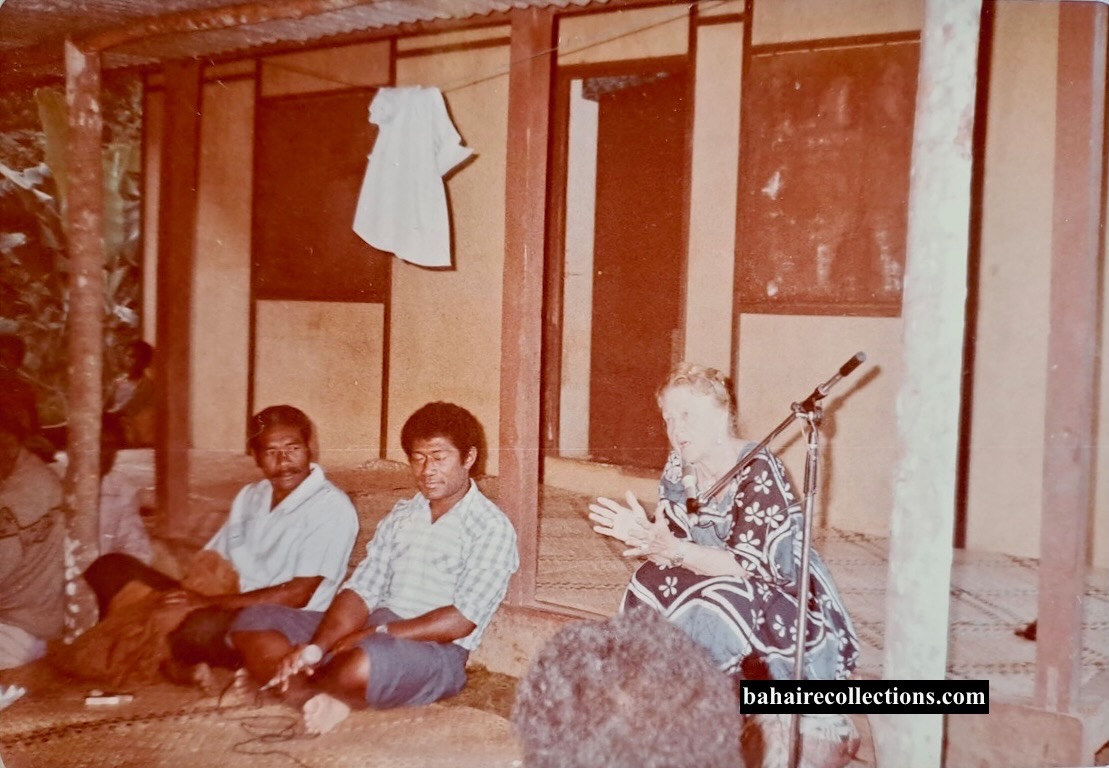
Meeting believers in Vanua Levu.
Because of the expense of holding the meeting it had been decided to make it a full 2 day conference. Rúhíyyih Khánum and Violette flew to Suva next day but Verona returned to Seaqaqa early to continue with the programme. Friday evening Rúhíyyih Khánum met with the National Spiritual Assembly and told them her impressions of her visit and how to help the Bahá’ís. After that the National Assembly held a dinner for her and the their spouses which finished her visit to Fiji on a very warm and friendly note.
THE DEDICATION OF THE BAHÁ’Í HOUSE OF WORSHIP IN SAMOA AS EXPERIENCED BY THE LUCAS FAMILY
The official story of the dedication of the Samoa House of Worship will be told elsewhere and this is the story of what happened to the Lucas family. We travelled on Thursday the 30th and arrived Wednesday the 29th because of crossing the International date line. A Persian couple who had stayed a few days in Fiji travelled with us and many other passengers were Bahá’ís. The plane nearly full in Fiji was diverted to American Samoa to pick up a football team who could not all get on. That made it hectic getting out of the airport at Apia. Alan Mauger, Verona’s brother was waiting for us when we exited the customs, which was a great relief. We had been up since 3:30 pm and the boys were a bit tired. When we cleared customs, which was quick once we explained we were coming for the Bahá’í dedication activities, Alan put us onto a bus arranged by the Bahá’ís. It was a normal Apia bus, a tiny bus with a body built over a truck with wooden bench seats and no room to stand. Alan told us we had been put into Betty Moore’s – a guest house. One other Samoan Bahá’í came with us to direct the bus and we took the long and pleasant drive to the town in perfect weather. There was lots of talk as people met old friends and struck up new acquaintances who had mutual friends elsewhere and caught up with the news. Our accommodation was ideally situated and perfect for our needs. Betty, a Bahá’í had cleared her relatives out of some big rooms come dormitories and put up our family in one room and the Marion family in another. Our room had nothing but five beds and the bathroom off to one side and cost US $20 a day for us all. Our communal kitchen and lounge room served for meals which we arranged for ourselves. Bert Marian brought a huge basket of paw paw, green coconuts and passion fruit. We were around the corner from Aggie Greys where Alan, Shirley and baby Chad were staying and 10 minutes’ walk to the gymnasium which is where the registration and teaching conference was being held. The conference began Friday and while we could register on Thursday the day was free. Our three sons dived into Aggie Grey’s pool and were impossible to extract unless it was for soft drinks and lollies. Now we arrived at the underlying theme of our stay in Apia.
The story began in Fiji at the meeting Rúhíyyih Khánum had with the pioneers. In the course of discussion Verona mentioned Chandra Naidu’s teaching method of bringing in whole Local Spiritual Assemblies and not just individuals. Quick as a flash Rúhíyyih Khánum asked what he was doing now? It was explained that being poor he works as a labourer to feed and keep a wife and four children. Immediately Rúhíyyih Khánum offered to subsidise him for a teaching project for two months. Later Verona presented a budget for such a project so she arranged it so that when we got to Samoa she would give all her leftover Fijian currency to Verona as an Auxiliary Board member and make up the balance with US currency.
In Apia, Richard and I went food shopping Wednesday afternoon, and we were walking back when Rúhíyyih Khánum and Violette drove past, recognised us and pulled over for a chat. After asking about us and commenting on how busy they were getting things ready at the House of Worship Rúhíyyih Khánum reminded us about the money and to make sure we got it.
On Thursday, Richard was harnessed into the workforce to lend a hand with the sound system. The boys spent all day in the pool and Shirley and I talked, shopped and met other Bahá’ís. In the afternoon Richard was at the House of Worship wiring it for the sound when Rúhíyyih Khánum walked past and said “Don’t forget that money I owe you”. The others around Richard stared at him with their mouths open. Alan and I took a taxi to the House of Worship for the photographs while the weather looked good. It was cloudy but okay and guaranteed some pictures no matter what the weather on the weekend. The children joined children’s classes while the conference took place. Their first activity was to form a choir under Russ Garcia and come and sing to the conference after the mid morning break. They were taken to Bahá’í headquarters for classes after that. I volunteered to help with the children in the afternoon so missed the NSA’s presentations.
Rúhíyyih Khánum’s opening address to the conference was powerful and dynamic and is recorded to posterity. What I remember most clearly was her saying how she knew more than half of us personally and some for more than 50 years. While she would have loved to spend time with all of us it was not possible and to accept her limitations. Her phenomenal memory of names and people’s services is a stunning attribute and heightens one awareness of how close God is to us. If a Hand of the Cause of God Rúhíyyih Khánum remembers us even though our contact is so small then how much better we are known by Bahá’u’lláh and God. Saturday was the dedication of the House of Worship. The morning was free but the counsellors organised a conference for Auxiliary Board members, National Spiritual Assembly members and other people to discuss the needs of the Pacific. It was such a frustrating meeting that most important decision was to reconvene with more time for consultation.
The dedication service was very beautiful and unique as it began with an address in Samoan and English from the Malietoa. A Christian dignitary who attended told the NSA chairman that he never attended so sacred or service in his life. Shirley and I sat outside for the service because children under 8 couldn’t attend and as the children found it all too much we got a taxi back to the hotels and missed the Sua ceremony for which Alan and Richard stayed and took lots of pictures.
Sunday morning was the viewing of the portrait of Bahá’u’lláh. It became very confusing about how it was being organised and except that children eight years and under could not take part there was not much information. It turned into three sessions. The House of Worship was filled, the doors closed and Rúhíyyih Khánum arrived and stood at the front of the aisle (and later sat) and anointed each person with attar of roses. The individual then walked across to the portrait looked at it and left the House of Worship. Ushers organised people out of their seats, so they were constantly moving but not too many standing at a time. When Richard came to be anointed Rúhíyyih Khánum lent over to him and whispered “When are you leaving Samoa?” “Wednesday” replied Richard. (O how we must have haunted her).
In the afternoon Rúhíyyih Khánum gave a wonderful speech to finish the programme. She spoke of how she and Violette just did not want to leave the Pacific and Galo the NSA secretary who was translating into the Samoan language broke down briefly.
The National Spiritual Assembly announced they were holding a special service at 8:00 PM so that everyone had a chance to attend a service before leaving Samoa. Alan was not feeling so well so he opted for the babysitting and Shirley was to come with us. The buses were picking people up at 7:30 PM but when we arrived at Aggie Greys we found that the full buses had already gone. Thinking we were late and not knowing whether more buses were coming Anthony Voykovitch who was waiting with and was one of the readers, hailed a taxi and filled it up with others and went off. Shirley then muttered about having to do something and to wait and dashed off. Then a bus arrived. It waited Shirley didn’t come so it left. Halfway up the hill there was an enormous shout and the bus stopped. Anthony Voykovitch and company climbed on board and their story soon had everyone in the bus in fits of laughter. Their taxi had run out of petrol and stranded them so when they saw the bus they shouted and Anthony, an actor, had a well trained loud voice so we stopped then we resumed the journey.
The House of Worship set the sky glowing and was surrounded by a luminous halo set up by the fine, misty cloud that is frequently part of the higher altitudes. The brilliant white of the dome sitting over the golden light of the building’s interior made it something of a heavenly vision – a glorious and a priceless jewel to decorate so worthy a cause. Someone later commented that when you come around the corner and suddenly see this building you ask yourself when did it land?
The whiteness of the building, its beauty and the bustle to get it ready for the dedication kept reminding me of a wedding. The House of Worship was the bride and the earth the groom and the service married the spirit and material sides of the Faith. The children of this marriage – the believers of the South Pacific.
The service was delayed. Rúhíyyih Khánum and Violette arrived about 8:20 PM and surprised many of us who knew just how tired she was. It was widely known that she was sweeping the floor of the House of Worship at midnight the previous evening to make it fit for the viewing of the portrait of Bahá’u’lláh. There were more delays. There was an electrical fault causing one of the light fittings to spark and crackle and enough lights had to be switched off to stop the noise. The service began and was worth the wait. The choir sang and sounded ethereal and heavenly as always with the type of acoustics that occur with the nine sided building and dome in the center.
Shirley had arrived and after the service I found her and she explained she had come up with Tom Price in his van and we could go back with him. So we set off together down a side path at the caretaker’s house where the car park was. We had to go through a garage, but we saw Rúhíyyih Khánum was there talking to the chairman and secretary of the National Spiritual Assembly of Samoa and telling them how to conduct the services for the House of Worship. We could not go past this scene without being very rude so we waited. Then Rúhíyyih Khánum looked up and saw Richard. “Is Verona here?” She asked and I was located. “Come with me in my car now and we will fix up the money business right now” she said. So it was that Violette drove us down the hill with Rúhíyyih Khánum. She spoke to us of how perfect the dedication service had been and the problems and beauty of this House of Worship. She compared it to the Panama House of Worship and its problems and the things that happened at that dedication. Rúhíyyih Khánum pours forth such a mine of information that unless you have a tape recorder you just must miss some of it.
When we arrived in town they took us to Betty Moor’s and went into the funny little lounge. Rúhíyyih Khánum rummaged in her purse and found she did not have her money with her. However we fixed up the details and arranged to get it from her hotel the next morning at 11:00 AM. She and Violette gave me a big hug and kiss and said their farewells and left. However, the Bahá’ís in the guesthouse had become aware that Rúhíyyih Khánum was in the lounge. One person had opened the door, seen us, apologised and backed off. Another had his room backing into the kitchen and heard her voice and not believing his ears had peeped in at the door and was stunned. When Rúhíyyih Khánum left they rushed out and hugged me (wanting to get some second-hand vibes) said one and wanted to know how such in such an incredible thing happened.
Next day the saga finally came to an end when Verona collected the money from Rúhíyyih Khánum’s room. Her room was something to behold. There was no room to sit although I found a small spot on the floor to sit and walking was a hazard because of all the gifts Rúhíyyih Khánum had received were being repacked. I said the room ought to be photographed for posterity because no one would ever believe how much work Rúhíyyih Khánum did on her travels. She didn’t think much of having her bedroom photographed but I thought no one would know it was a bedroom. How would you see where the bed was? The point about telling this is to convey a glimpse of how much work the “first lady” of the Bahá’í Faith does. Her free days on any trip are extremely busy writing reports making arrangements for the next stage of the trip and attending to many details that are essential for the smooth flow of her travels. The immeasurable sense of power that emanates from her – she is an absolute command of her activities yet completely in the hands of the Universal House of Justice, fellow Hands of the Cause, Counsellors and National Spiritual Assemblies for whom she shows a love and respect that sets a high example for us to follow. I got the impression of a stern, loving and strict disciplinary type headmistress, who wanted her children to go out into the world in immaculate condition yet they would love her always for her kindness and humility. She was forever admonishing, warning and teaching showering her love on the island people and ticking off those with pretensions. There was also an impression of the top General inspecting the troops before the final assault. The General being the Universal House of Justice with Rúhíyyih Khánum being the eyes and ears and legs on its behalf.
Richard’s comment on the whole episode was “I never dreamed that we would ever have come so close to those two ladies.”
Rúhíyyih Khánum quoted a statement of ‘Abdu’l-Bahá that the difference between us and the people of the future was far, far greater than the difference between us and the caveman otherwise she would not be doing this work. So to the people of the future, we dedicated this glimpse of a wonderful, incredible woman.
THINGS THAT HAPPENED POST THIS EVENT
Chandra Naidu. As the recipient of Rúhíyyih Khánum’s wonderful gift and generosity Chandra set out to undertake some teaching work. His ‘method’ was to meet all the members of the community who were of Indian background and talk about the oneness of all religions and explain the Bahá’í Faith with an emphasis on the administrative structure. About 16 or so people would accept the Faith which meant that a Local Spiritual Assembly could be formed. His response to this funding was to go to Taveuni where he had relatives and teach there. Several villages were given the message. However, this was prior to the Institute process and we were unable to follow up his work, particularly as there were few strong Bahá’ís on Taveuni which was quite a distance with boat and road travel involved.
Firoozeh Yaganei and teaching Indians in Fiji. Firoozeh was the Knight of Bahá’u’lláh for Goa a steadfast and enthusiastic teacher of the Faith. Verona knew her from her time in Sydney as she resided in Randwick community for a short while where Firoozeh lived with her family. Firoozeh was a friend of Rúhíyyih Khánum and spoke of cooking for the Guardian. Firoozeh and her family attended the dedication of the House or Worship in Samoa. Rúhíyyih Khánum had been apprised of the problem that the Fijian Bahá’í community faced in being unable to reach the Indo Fijian community so she charged Firoozeh to teach the Indians in Fiji. However, there was a qualification. Firoozeh should not pioneer and live in Fiji but visit it regularly to reach the Indians and follow up with each visit. Thus began a long lasting relationship between Firoozeh and the Bahá’í community in Fiji that went until her health deteriorated to the degree she could no longer travel.
In response to Rúhíyyih Khánum’s request Firoozeh and her family came to Fiji on their way back from Samoa. They traveled by bus to Lautoka and were discussing what to do and where to find a restaurant when they got to Lautoka. A young Indian couple sitting in front of them on the bus overheard the conversation and offered to help them when they got to Lautoka. Thus they met Randhir Sen and Vijay Verma who were engaged to be married later in the year. Firoozeh sent a wedding gift and charged the Lucas to give it to them. Vijay and Sen accepted the Faith and over time all of Vijay’s family in Lautoka and Sen’s family in Labasa accepted the Faith. Of all those of Indian background who accepted the Faith Vijay and Sen were probably the longest serving in Fiji with outstanding contributions. As happened to so many of the talented and committed Indians who accepted the Faith they eventually had to leave Fiji from the political and racial prejudices limiting them from serving the country in their chosen professions and went on to serve the Faith in New Zealand and Australia.
While there is no doubt that Firoozeh’s presence in Fiji brought this wonderful family to the Faith they were not the only ones whom she taught. Those who accepted the Faith through her loved her and came out to have her stay with them and listen to her teaching whenever she was in Fiji. In between they were essentially inactive despite visits from other local believers.
1998 International Convention
Without doubt the 1998 International Convention was the most successful up to that point in time with more NSAs having all 9 members attend than previously with many more having 8 members which included Fiji which had never had so many attend together before. Rúhíyyih Khánum was close to the end of her life as she passed away in January 2000 and her health was not good. Nonetheless she attended the Convention and gave a short talk. When the voting took place she and Violette sat in the front row of the auditorium where Rúhíyyih Khánum was wrapped in a fur coat. When the Fijian delegates were announced and were wearing tapa designed outfits and traditional dress she sat up and clapped and commented to Violette as she was obviously happy to see us.
The passing of Rúhíyyih Khánum
The Bahá’í world was deeply saddened at the news of the passing of Amatu’l-Bahá Rúhíyyih Khánum announced by the Universal House of Justice. Hard on the heels of this announcement came an invitation from the Universal House of Justice for 1 or 2 members of every National Assembly to attend the funeral in recognition of how Rúhíyyih Khánum had traveled so widely and knew so many of us. The only member of the Fiji NSA able to move quickly enough without travel issues was Verona. There were many stories of how people came to the funeral against all sorts of odds and it seemed that Rúhíyyih Khánum had organized the guests from the realms of the other world. One such story came from a woman from one of the African countries. It was absolutely impossible to leave that country without all sorts of complications with their immigration procedures. This lady had never had such a smooth departure and the officials also sent a message of sympathy with her at the passing of “Madam Rabbani”. She also wanted a ‘sign’ of some sort while she was in the Holy land.
The funeral service was held at the Master’s House which would become a museum reflecting Rúhíyyih Khánum’s travels. Following the service the casket was carried outside across the road to where her burial was to take place. The lady from Africa was not far behind the casket and a flower fell off it onto the steps. One person had stepped on part of it but before it was crushed, she bent down and picked it up recognizing this as the ‘sign’ and that this flower would be pressed and return to Africa, a country of great significance in Rúhíyyih Khánum’s life.
Mary
Back in Fiji a cable came to say that Rúhíyyih Khánum’s niece, Mary would be in Nadi on her way to Samoa and would we please meet her. Mary was close to Rúhíyyih Khánum and was one of two people who nursed and cared for her in her final months. Mary’s husband was involved with the America’s cup which was being raced in New Zealand at this time. The other woman who cared and nursed Rúhíyyih Khánum was a woman from Samoa. Rúhíyyih Khánum told Mary to go to Samoa for a rest after all the hard work of caring for her. Mary was arranging to leave as it was not clear when Rúhíyyih Khánum would depart this world. Before Mary was able to leave Rúhíyyih Khánum passed on. Mary was a talented artist with flower arrangements and decorations. She did all the flowers and settings for the funeral. No one was permitted to photograph the set up so it was a huge privilege for us to see Mary’s photographs as it was impossible to take it all in at the time. We were greatly blessed as Mary also stopped again in Fiji when she left Samoa and we had another visit with her.

Verona Lucas
FIJI
30 April, 2023
About the author:
Verona, Elizabeth Lucas, born in Perth, Western Australia, in 1946 recognized the fulfillment of Christ’s promise to ‘return’ after reading the short history of the martyrdom of the Báb given by Rúhíyyih Khánum in her book “Prescription for living” in 1967. She pioneered to Fiji and married Richard Livingstone Lucas in 1971 and completed that goal for the Australian Nine-Year Plan. Through extraordinary circumstances they remained in Fiji to the time of writing (2023) during which period she served as an Auxiliary Board member for 5 years, then on the National Spiritual Assembly of the Bahá’ís of Fiji for 12 years. Her task now is to record all that they remember for Fiji’s historical records.
Copyright©bahairecollections.com